Documenting my PCT journey, and staying in touch
While I’m out hiking the PCT, I’ll be carrying a handful of electronics: camera, SPOT Satellite Personal Tracker, and smart phone. I’m bringing these to stay in touch with my family & friends from towns, record memories of trail life, and have an emergency beacon for if I break a femur and need an emergency evacuation.
I’m glad to be living in the information age, with all these technologies at my fingertips. What sounds wretched, though, is to be walking through the high desert/range of light/green tunnel, staring at glowing rectangles.
After all, this is (part of) why I hike: to get away from the creep of electronics into every facet of my life.
So why bring any electronics on the PCT?
Well, for me, the benefits of some gadgets outweigh the cost to the wilderness experience. It’s a grey zone, and I’m not completely at peace with how much weight I’m dedicated to high-tech tools, but for now, it’s worth it. I deal in part by submitting to luddite urges as well, by carrying paper maps and a paper journal.
Documenting the journey
Let’s start with the camera. Though I’m not an accomplished, or even particularly well-informed photographer, I enjoy the act of taking pictures. Since my first international trip, to India as a high school exchange student, I’ve always brought a camera, and have never regretted it. Nothing brings back memories of a place or the people with me faster than looking at the trip photos (none of which are in albums — I’m not *that* organized).
My camera system for this trip is a Canon S100 with two extra batteries, two extra memory cards, and a USB memory card reader; with the battery charger, it weighs in at 11.15 oz. My camera case is the foot of a sock, mostly just to protect the screen from scratches, and I’ll be carrying the camera itself in one of my waistbelt pouches.
Three batteries lasted me the entire 20 days on the JMT without recharging, so I feel confident about getting from town to town (where I’ll gleefully run chargers under tables while eating burgers). If I fill up a memory card, I’ll send it back to Russell, who will download the pics using another card reader, then send it back up the trail. When I have access to computers in towns (hostels? libraries?), I will be able to use the card reader I carry to upload photos from the camera to this blog.
I have this memory of going to look at the Mona Lisa at the Louvre in Paris, and finding myself in a sea of people looking at it through the screen of their camera or phone. It shook me then, and horrified me a bit — though I’ve been just as guilty as those folks of taking pictures more than really looking.
On this trip, while I do want to take pictures, I’ll be working to make sure my camera doesn’t get in the way of looking.
Keeping found
The newest addition to my pack is the SPOT device my father mailed to me to try out. He brings it with him on bicycle trips so that family can know how his trip is going, and get help to him in case of the unexpected. I was not initially planning to bring any sort of GPS or locator beacon, but after requests from loved ones and taking that wilderness medicine course, I’ve come around. Particularly since this one is here, now, and free of charge to me. Thanks, Jene-Paul!
This 1st Generation SPOT Satellite Personal Tracker can send OK, Help, and 911 messages, as well as send a location to an online map every 10 minutes in tracking mode. I’ve spent some time over the last few days learning how to send OK messages and use tracking mode, and feel solid on its operation. It has no screen, or way for me to communicate out. With batteries, the SPOT weighs 7.4 oz; an extra set of batteries adds another 1 oz.
My primary reason for bringing the SPOT will be to let Russell and the rest of my family know I’m doing well out in the wilderness, and follow my progress. It will be good to know there’s a higher chance of rescue if something goes really wrong (and I don’t have cell service), but I will not be relying on the device to save me. Prevention, smart decisions, and not touching snakes will be far more important to me on the trail than a beacon.
Phoning home in the post-pay-phone era
Last spring, I drove across the country to work in Maine for a season. I spent the first night in a motel in Barstow, and didn’t notice until I crossed the Nevada border the next morning that I’d left my phone behind. At the time, I shrugged and thought “this adds to the adventure!” I imagined using pay phones in roadside diners, and being that much more Authentic. HA.
Turns out, the rise of the cell phone meant the fall of the pay phone. While part of me had known this, it didn’t hit home until I got to Kansas and still hadn’t seen a single one. I finally broke down and asked the owner of a gas station convenience store if I could use his cell. From there, I quickly signed up for a new phone, and jumped back on the ultra-wired bandwagon. Sigh.
I won’t be making the same mistake on this trip. The last thing I want, once I get to a small town, is to have no way to text or call home, or to be entirely at the mercy of strangers. Now, my experience has been that strangers are pretty darn merciful, but I don’t want to depend on that.
My phone is a scrappy AT&T iPhone 4, generally donated by a upgrading friend several months back. I’ll be carrying it turned off in my pack, to reserve battery for emergencies. I have some eBooks loaded up in my Kindle App if I need reading material, and can use it as a backup camera if I drop the Canon in a lake. I’ve heard AT&T doesn’t get great service on the trail but I’m not willing to get a new phone just to get better service. With the lovely wooden backplate (she put a bird on it!), it weighs 5.0 oz.
Journaling on the trail
I am a compulsive travel-journaler. I don’t keep a regular diary in town, but on the road, woo-wee, do I go through paper. I filled 4 or 5 notebooks in one year of study abroad, and each trip thereafter has seen near-daily journal entries.
Writing every night on the John Muir Trail gave structure to my evenings, and helped me see progress in fitness and mileage. Since night has historically been my least favorite time on the trail, I want to do everything I can on the PCT to mitigate the loneliness and fear, and journaling is a big part of that.
After several weeks of searching, I decided on a small Moleskine softcover lined journal. With pen, this will set me back 4.25 oz. I can use the paper to leave notes; I’ll pop a few sheets into my first aid kit too. When I get close to finishing the first journal, Russell can mail me another, and I’ll send the full one home.
Now, to make sure I’m experiencing the trail with my eyes, ears, nose, fingers, and mind too…
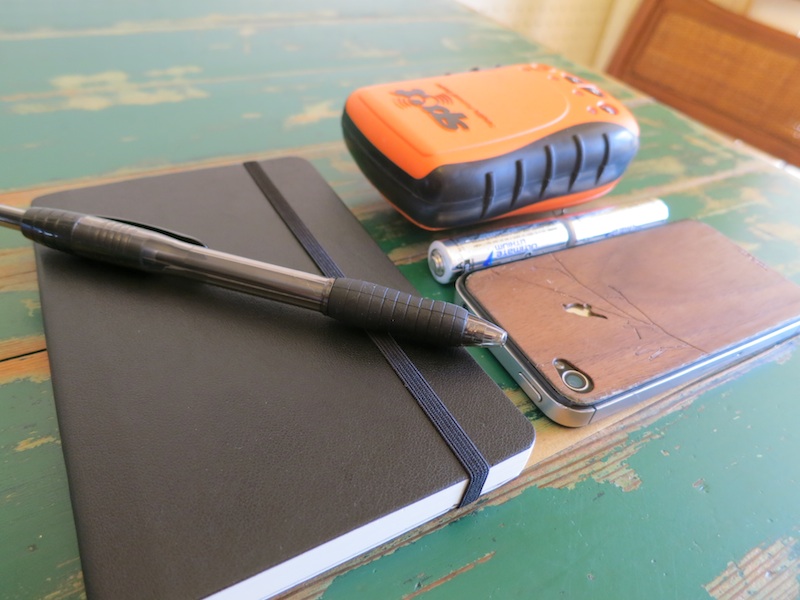

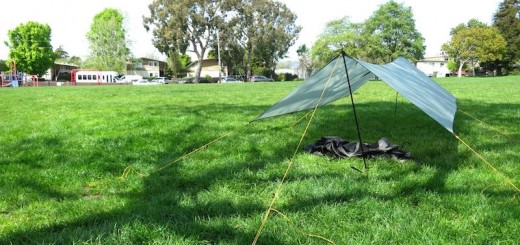




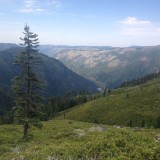


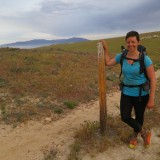

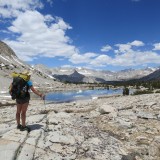
Glad that you’re taking the SPOT! To give you an idea of battery life – I put new lithiums in the morning we left HI and kept it turned on “tracking mode” every day from ~8am to ~8pm and made it through the whole JMT without having to replace the batteries. Only works with lithium though, we tried to use Alkaline on a short trip since I’ve been back and it was dead within a matter of hours. Good luck with it!
Good to know. I’ve got 3 fresh packs of lithium batteries for resupplies. Planning to change them out once a month, per my old man’s recommendation.
Yes.
Situational awareness is your best preventive measure in terms of safety. Know your limits and address them in your solutions.
You’ve so got this, Alice. The Canon & SPOT gizmos are not nearly as important as the Moleskine journal. Each day you assess & archive there will provide a process of resolution permitting you to see more clearly, bit by bit, on each successive day. The camera takes spotty shorthand by comparison and *SPOT* is all math – it doesn’t know what forest detritus smells like and it can’t see the palette of color streaming through the trees and splashing down canyons or distinguish bird calls from pikas whistling. Enjoy every step.
Keeping a journal does seem like a very important part of all this, I can only imagine though. We’re all thinking of you and will be cheering you on from afar, which might not help every lonely night, but maybe it will help on some of them. I just can’t get over how brave you are, while at the same time knowing that you are completely capable of this. I can’t wait to see who you have become and how you have grown when you reach the other side.
My brother suggested I might like this blog.
He waas totally right. This post actually made my day.
You can not imagine simply how much time I had spent for
this info! Thanks!